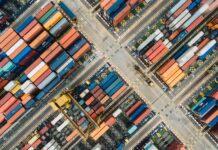
A new research project has commenced to design a framework and operational requirements within a digital twin to simulate autonomous short-haul container transfers at the Port of Brisbane.
Over the next 12 months, port of Brisbane in partnership with Queensland University of Technology and iMOVE Australia will consider the regulatory, safety, technical, and security requirements of an ecosystem to support container transfers between port facilities using low/zero-emission autonomous vehicles.
With freight volumes growing and a declining truck driver workforce, the research collaboration will explore how low/zero-emission autonomous vehicles could supplement requirements by supporting container movements between terminals, depots, and the PBPL-operated Brisbane Multimodal Terminal, the interface for road and rail at the Port.
Port of Brisbane CEO Neil Stephens stated the project was a key initiative identified through its recently released Vision 2060 an ambitious roadmap designed to strengthen Queensland’s economic position, future proof trade, and support the transition to a more sustainable and efficient port.
The Vision identified that by 2060, Queensland’s population is expected to reach 8.3 million from around 5.5 million in 2024, with container trade through the Port of Brisbane tripling over this time, Mr Stephens added.
As container volumes increase to meet Australia’s growing population and trade demands, ports are under pressure to handle higher throughput while pursuing decarbonization strategies and maintaining the highest safety levels.
This project is a first-of-its-kind for the Port of Brisbane and represents a step toward enabling seamless connectivity in and around the port to support this future growth.
The Port of Brisbane continues playing a vital role in Queensland’s economic prosperity, contributing US$11 billion to the state’s economy in FY24 and supporting more than 73,000 jobs across its supply chain.





